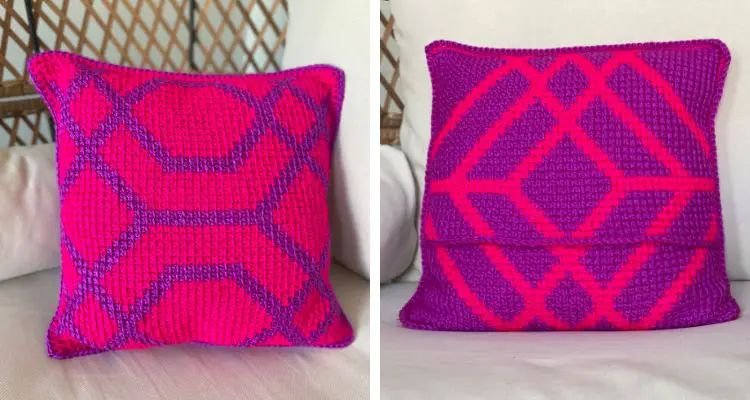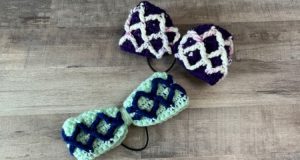What do you get when you pair two colors of yarn, a Tunisian crochet hook and a pillow form? A vibrant Tunisian crochet pillow for your sofa, favorite chair, bedroom or office! It’s time to add a pop of color and style to your decor.
But hold on a second, what exactly is Tunisian crochet? If you’re scratching your head and picturing a crochet hook with a beret, fear not! Tunisian crochet is a unique technique that combines the best of both crochet and knitting. It creates a beautifully textured fabric that’s perfect for pillows, blankets, and even garments.
Now, let’s talk about the star of the show – Shuri Tunisian Crochet Pillow. With its eye-catching geometric pattern shown in bright pink and purple yarns, this tunisian crochet pillow is sure to make a statement in any room. Whether you want to add a splash of color to your living room or create a cozy accent for your bedroom, this pillow has got you covered (literally!).
But why should you make your own pillow instead of buying one from a store? Well, besides the satisfaction of creating something unique with your own two hands, making your own pillow allows you to unleash your creativity and customize it to match your personal style. Plus, it’s a fantastic way to learn Tunisian crochet stitches and even dip your toes into the world of graphghan crochet – a technique that uses charts to create intricate color work designs. So not only will you end up with a gorgeous pillow, but you’ll also gain valuable skills along the way.
So grab two colors of yarn, a tunisian crochet hook with a cable, yarn needle, some stitch markers or clamps, and get ready for an exciting Tunisian crochet adventure. Get ready to make a statement with your very own handmade masterpiece!
Why color work for a Tunisian crochet pillow?
Why not???
Any handmade pillow is a great opportunity to display one’s creativity by making something that matches a style, or go bold with color and technique. A tunisian crochet pillow is perfect for all of the above and more.
By making a 16″ x 16″ pillow, it’s a common size for throw pillows to add to a sofa or comfy chair. It’s also a size that provides a reasonably sized canvas to practice and begin mastering a technique. The Shuri Tunisian Crochet Pillow features stranded color work.
What is stranded color work? It is a form of color work in which you work with one color at a time along a row or round, and “float” or carry the unused color(s) along the back to where that color is needed. You will not work over the unused color. This method creates a neat right side of the fabric with the design or image, and a wrong side of the fabric full of floats. Warning, the floats can easily be caught on other objects, if this color work technique is used for a project that will be worn or carried.
Hopefully, you know or are getting to know Creations by Courtney for clever modifications. The detail of color work in this tunisian crochet pillow “needed” the floats to be “secured.” Rather than creating several small balls of yarn to pick up as needed, you will carry both colors along each forward and return pass. I think this creates a neater design at the color change points, and it surprisingly tangles less with fewer attached yarns to manage.
The modification is straightforward. Rather than dropping the color to pick up when needed, you will carry it along and “catching it” with the color being used. Refer to this tutorial for a demonstration.

Yarn
We cannot talk about crochet without talking about the yarn. With lots of wonderful options, there’s no limit to color combinations that can be created for this tunisian crochet pillow.
The yarn for the Shuri Tunisian Crochet Pillow was provided by Crochet Foundry. I had 52 colors of Furls Wander to choose from, which was bit challenging. This is probably one of the reasons why Furls offers pallets of color to make it easier to choose multiple colors that coordinate. Rather than playing it safe by choosing popular or neutral shades, I choose two bright colors. I can admit that it was tough and go making the practice swatch, as Orchid and Festival are quite bright, but I love how it came together!
If you have not tried Furls Wander, I hope you’ll get a few skeins to try for this crochet project. Each skein is a worsted weight with a put-up of 120 yards / 109 meters per 100 grams. It’s a reasonably priced 100% acrylic yarn at $5 per skein. You can save when purchasing for larger projects by getting a 10-pack for just $39.50.
I like the sheen of this yarn, and it’s softness that works great for home decor to wraps to a Coll weather cardigan.
Furls Crochet Blog Hop
It’s a pleasure to work with Furls for the 2024 Blog Hop, which originally started in 2020. Each week will feature a new free crochet pattern by a variety of your favorite and new to you designer. I hope you will check out each featured pattern and share with your fiber friends.
*Disclosure: This post may contain affiliate links to products that I use, and think you will enjoy using too. Should you decide to use any such link, I will earn a small commission at no cost to you. Thank you for supporting this small business.
ADD TO RAVELRY FAVORITES
MATERIALS
- Furls Fiberarts Wander Acrylic Yarn, #4 worsted weight yarn (100% acrylic; 120 yds/ 109 m; 3.5 oz/ 100 g):
- Color A: Festival x 2
- Front: 111 yds /101.5 m
- Back x 2: 49 yds / 45 m EACH
- Color B: Orchid x 3
- Front: 81 yds / 74 m
- Back x 2: 46 yds / 42 m
- US L (8 mm) tunisian crochet hook or tunisian crochet hook to meet gauge
- US I (5.5 mm) crochet hook. I used a Borealis Streamline Galaxy Crochet Hook.
- Scissors
- Yarn Needle
- Measure Tape
- 16” square pillow form
GAUGE
12 sts x 11 rows in pattern = 4” x 4” [10 cm x 10 cm]
FINISHED SIZE(S)
16″ wide x 16″ long
PATTERN KEY
Ch: chain
Cnr: corner
FwdP: forward pass
FO: fasten off
Rem: remain(s)
Rep: repeat
RetP: return pass
Sc: single crochet
Sk: skip
Sl st: slip stitch
St(s): stitch(es)
Tss: tunisian simple stitch
YO: yarn over
SPECIAL STITCHES & TECHNIQUES
Last St (counts as tss): insert hook under both loops from front to back, YO, pull up a loop
RetP: YO, pull through one loop (ch 1), *YO, pull through 2 loops, rep from * to end
Tss: insert hook under next vertical bar, YO, pull up a loop
EXPERIENCE LEVEL
Intermediate
NOTES
- Pattern is written in US terms.
- Read entire pattern before beginning.
- The first loop on the hook counts as the first st.
- Always sk 1st vertical bar.
- Do not turn work, unless indicated.
- Each row is completed with a FwdP and RetP.
- Each color is carried along the back.
- Repeats are indicated as[(B) x 3, (A) x 1] x 2, which means to repeat the instructions within the [ ] the number of times listed
- The Shuri Pillow is made in 3 pieces, Front and two pieces for the Back, bottom and top.
Purchase the ad-free PDF from your favorite pattern shop
Don’t forget to join the Creations By Courtney Community for CALs, crochet tips, and yarnie fun.
INSTRUCTIONS
Front
Ch 50
Row 1: Starting in 2nd ch from hook, (A) x 6, [(B) x 3, (A) x 1] x 2, (A) x 6, (B) x 10, (A) x 6, [(A) x 1, (B) x 3] x 2, (A) x 6
Row 2: (A) x 7, (B) x 5, (A) x 7, (B) x 12, (A) x 7, (B) x 5, (A) x 7
Row 3: [(B) x 1, (A) x 7, (B) x 2] x 2, (B) x 1, (A) x 8, [(B) x 3, (A) x 7] x 2, (B) x 1
Row 4: [(B) x 2, (A) x 5, (B) x 3] x 2, (A) x 10, [(B) x 3, (A) x 5, (B) x 2] x 2
Row 5: [(B) x 3, (A) x 3, (B) x 3, (A) x 1] x 2, (A) x 10, [(A) x 1, (B) x 3, (A) x 3, (B) x 3] x 2
Row 6: [(A) x 1, (B) x 3] x 2, (A) x 2, [(A) x 1, (B) x 3] x 2, (A) x 14, [(B) x 3, (A) x 1] x 2, (A) x 1, [(A) x 1, (B) x 3] x 2, (A) x 1
Row 7: [(A) x 2, (B) x 5, (A) x 3] x 2, (A) x 13, (B) x 5, (A) x 5, (B) x 5, (A) x 2
Row 8: [(A) x 3, (B) x 3, (A) x 4] x 2, (A) x 14, (B) x 3, (A) x 7, (B) x 3, (A) x 3
Row 9: [(A) x 3, (B) x 3, (A) x 4] x 2, (A) x 14, (B) x 3, (A) x 7, (B) x 3, (A) x 3
Row 10: [(A) x 2, (B) x 5, (A) x 3] x 2, (A) x 13, (B) x 5, (A) x 5, (B) x 5, (A) x 2
Row 11: [(A) x 1, (B) x 3] x 2, (A) x 2, [(A) x 1, (B) x 3] x 2, (A) x 14, [(B) x 3, (A) x 1] x 2, (A) x 1, [(A) x 1, (B) x 3] x 2, (A) x 1
Row 12: [(B) x 3, (A) x 3, (B) x 3, (A) x 1] x 2, (A) x 10, [(A) x 1, (B) x 3, (A) x 3, (B) x 3] x 2
Row 13: [(B) x 2, (A) x 5, (B) x 3] x 2, (A) x 10, [(B) x 3, (A) x 5, (B) x 2] x 2
Row 14: [(B) x 1, (A) x 7, (B) x 2] x 2, (B) x 1, (A) x 8, [(B) x 3, (A) x 7] x 2, (B) x 1
Row 15: (A) x 7, (B) x 5, (A) x 7, (B) x 12, (A) x 7, (B) x 5, (A) x 7
Row 16: (A) x 6, [(B) x 3, (A) x 1] x 2, (A) x 6, (B) x 10, (A) x 6, [(A) x 1, (B) x 3] x 2, (A) x 6
Row 17: (A) x 4, [(A) x 1, (B) x 3, (A) x 2] x 2, (A) x 20, [(B) x 3, (A) x 3] x 2, (A) x 2
Row 18: (A) x 4, [(B) x 3, (A) x 5] x 2, (A) x 14, [(A) x 1, (B) x 3, (A) x 4] x 2
Row 19: [(A) x 3, (B) x 3, (A) x 4] x 2, (A) x 14, (B) x 3, (A) x 7, (B) x 3, (A) x 3
Row 20: [(A) x 2, (B) x 3, (A) x 7] x 2, (A) x 9, (B) x 3, (A) x 9, (B) x 3, (A) x 2
Row 21: [(A) x 1, (B) x 3, (A) x 10] x 2, (A) x 4, (B) x 3, (A) x 11, (B) x 3, (A) x 1
Row 22: (B) x 3, (A) x 13, (B) x 18, (A) x 13, (B) x 3
Row 23: (B) x 3, (A) x 13, (B) x 18, (A) x 13, (B) x 3
Row 24: [(A) x 1, (B) x 3, (A) x 10] x 2, (A) x 4, (B) x 3, (A) x 11, (B) x 3, (A) x 1
Row 25: [(A) x 2, (B) x 3, (A) x 7] x 2, (A) x 9, (B) x 3, (A) x 9, (B) x 3, (A) x 2
Row 26: [(A) x 3, (B) x 3, (A) x 4] x 2, (A) x 14, (B) x 3, (A) x 7, (B) x 3, (A) x 3
Row 27: (A) x 4, [(B) x 3, (A) x 5] x 2, (A) x 14, [(A) x 1, (B) x 3, (A) x 4] x 2
Row 28: (A) x 4, [(A) x 1, (B) x 3, (A) x 2] x 2, (A) x 20, [(B) x 3, (A) x 3] x 2, (A) x 2
Row 29: (A) x 6, [(B) x 3, (A) x 1] x 2, (A) x 6, (B) x 10, (A) x 6, [(A) x 1, (B) x 3] x 2, (A) x 6
Row 30: (A) x 7, (B) x 5, (A) x 7, (B) x 12, (A) x 7, (B) x 5, (A) x 7
Row 31: [(B) x 1, (A) x 7, (B) x 2] x 2, (B) x 1, (A) x 8, [(B) x 3, (A) x 7] x 2, (B) x 1
Row 32: [(B) x 2, (A) x 5, (B) x 3] x 2, (A) x 10, [(B) x 3, (A) x 5, (B) x 2] x 2
Row 33: [(B) x 3, (A) x 3, (B) x 3, (A) x 1] x 2, (A) x 10, [(A) x 1, (B) x 3, (A) x 3, (B) x 3] x 2
Row 34: [(A) x 1, (B) x 3] x 2, (A) x 2, [(A) x 1, (B) x 3] x 2, (A) x 14, [(B) x 3, (A) x 1] x 2, (A) x 1, [(A) x 1, (B) x 3] x 2, (A) x 1
Row 35: [(A) x 2, (B) x 5, (A) x 3] x 2, (A) x 13, (B) x 5, (A) x 5, (B) x 5, (A) x 2
Row 36: [(A) x 3, (B) x 3, (A) x 4] x 2, (A) x 14, (B) x 3, (A) x 7, (B) x 3, (A) x 3
Row 37: [(A) x 3, (B) x 3, (A) x 4] x 2, (A) x 14, (B) x 3, (A) x 7, (B) x 3, (A) x 3
Row 38: [(A) x 2, (B) x 5, (A) x 3] x 2, (A) x 13, (B) x 5, (A) x 5, (B) x 5, (A) x 2
Row 39: [(A) x 1, (B) x 3] x 2, (A) x 2, [(A) x 1, (B) x 3] x 2, (A) x 14, [(B) x 3, (A) x 1] x 2, (A) x 1, [(A) x 1, (B) x 3] x 2, (A) x 1
Row 40: [(B) x 3, (A) x 3, (B) x 3, (A) x 1] x 2, (A) x 10, [(A) x 1, (B) x 3, (A) x 3, (B) x 3] x 2
Row 41: [(B) x 2, (A) x 5, (B) x 3] x 2, (A) x 10, [(B) x 3, (A) x 5, (B) x 2] x 2
Row 42: [(B) x 1, (A) x 7, (B) x 2] x 2, (B) x 1, (A) x 8, [(B) x 3, (A) x 7] x 2, (B) x 1
Row 43: (A) x 7, (B) x 5, (A) x 7, (B) x 12, (A) x 7, (B) x 5, (A) x 7
Row 44: (A) x 6, [(B) x 3, (A) x 1] x 2, (A) x 6, (B) x 10, (A) x 6, [(A) x 1, (B) x 3] x 2, (A) x 6
Bind Off: sl st in each vertical bar and last st, FO A and B.
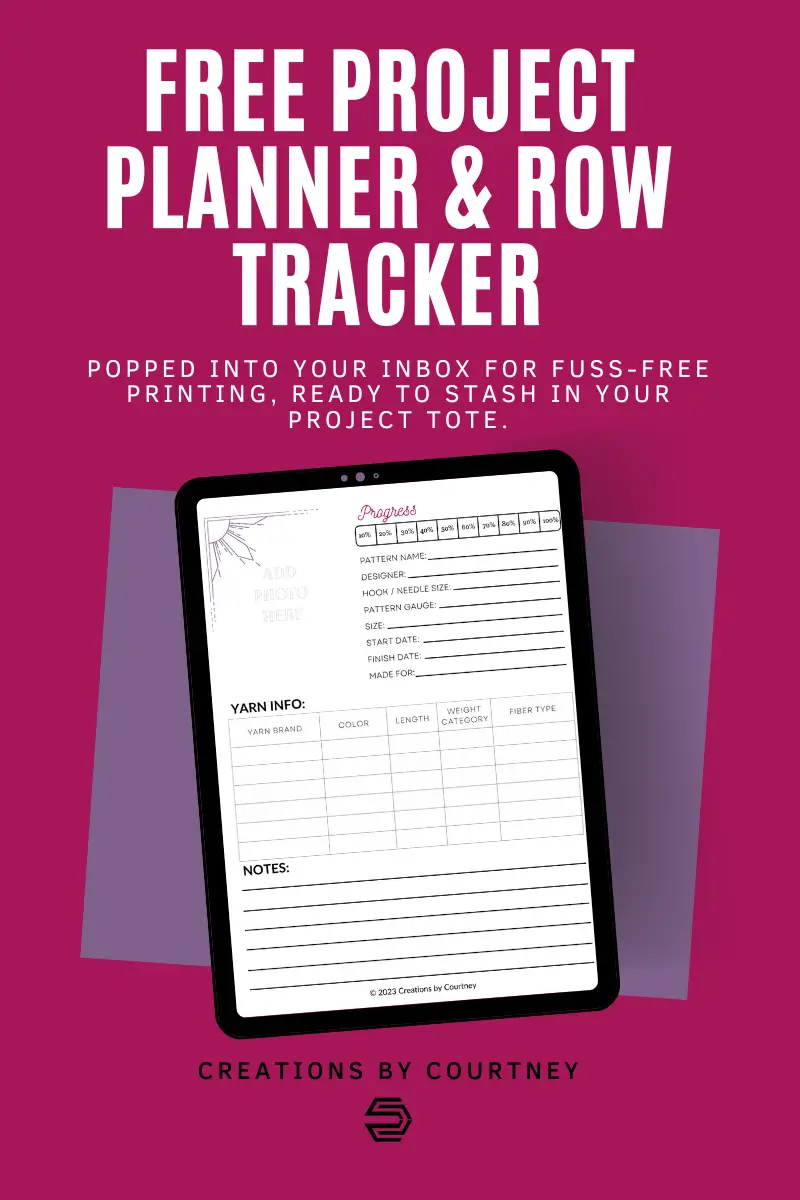
Back Bottom
Ch 51,
Row 1: Starting in 2nd ch from hook, (B) x 12, [(A) x 3, (B) x 2] x 2, [(A) x 3, (B) x 1] x 2, [(B) x 1, (A) x 3, (B) x 1] x 2, (B) x 11
Row 2: (B) x 13, (A) x 6, (B) x 4, (A) x 5, (B) x 4, (A) x 6, (B) x 13
Row 3: (B) x 14, (A) x 4, (B) x 6, (A) x 3, (B) x 6, (A) x 4, (B) x 14
Row 4: (B) x 14, (A) x 4, (B) x 5, (A) x 5, (B) x 5, (A) x 4, (B) x 14
Row 5: (B) x 13, (A) x 6, (B) x 2, [(B) x 1, (A) x 3] x 2, (B) x 3, (A) x 6, (B) x 13
Row 6: (B) x 12, (A) x 3, [(B) x 2, (A) x 3, (B) x 1, (A) x 3, (B) x 1] x 2, (B) x 1, (A) x 3, (B) x 12
Row 7: (B) x 11, (A) x 3, (B) x 4, (A) x 5, (B) x 5, (A) x 5, (B) x 4, (A) x 3, (B) x 11
Row 8: (B) x 10, [(A) x 3, (B) x 6] x 2, [(B) x 1, (A) x 3, (B) x 5] x 2, (B) x 5
Row 9: (B) x 8, [(B) x 1, (A) x 3, (B) x 6] x 4, (B) x 3
Row 10: (B) x 8, (A) x 3, (B) x 6, [(B) x 1, (A) x 5, (B) x 4] x 2, (B) x 3, (A) x 3, (B) x 8
Row 11: (B) x 7, (A) x 3, (B) x 6, [(B) x 1, (A) x 3] x 2, (B) x 2, [(B) x 1, (A) x 3] x 2, (B) x 7, (A) x 3, (B) x 7
Row 12: (B) x 6, (A) x 3, (B) x 6, [(B) x 1, (A) x 3, (B) x 3, (A) x 3] x 2, (B) x 7, (A) x 3, (B) x 6
Row 13: (B) x 5, (A) x 3, (B) x 7, [(A) x 3, (B) x 5, (A) x 2] x 2, (A) x 1, (B) x 7, (A) x 3, (B) x 5
Row 14: (B) x 4, [(A) x 3, (B) x 7] x 4, (A) x 3, (B) x 4
Row 15: [(B) x 3, (A) x 3, (B) x 4] x 2, (B) x 3, (A) x 4, [(A) x 1, (B) x 7, (A) x 2] x 2, (A) x 1, (B) x 3
Row 16: [(B) x 2, (A) x 3, (B) x 5] x 2, (B) x 1, [(B) x 1, (A) x 3] x 2, (B) x 7, (A) x 3, (B) x 7, (A) x 3, (B) x 2
Row 17: [(B) x 1, (A) x 3, (B) x 6] x 2, [(B) x 1, (A) x 3, (B) x 2] x 2, (B) x 5, (A) x 3, (B) x 7, (A) x 3, (B) x 1
Row 18: [(A) x 3, (B) x 7] x 2, [(A) x 3, (B) x 5] x 2, (B) x 2, (A) x 3, (B) x 7, (A) x 3
Row 19: [(A) x 2, (B) x 7, (A) x 1] x 5, (A) x 1
Row 20: [(A) x 1, (B) x 7, (A) x 2] x 2, (A) x 1, (B) x 8, [(B) x 1, (A) x 3, (B) x 6] x 2, (B) x 1, (A) x 1
Row 21: (B) x 6, [(B) x 1, (A) x 3, (B) x 6] x 2, (B) x 4, [(B) x 1, (A) x 3, (B) x 6] x 2, (B) x 1
Row 22: (A) x 19, (B) x 13, (A) x 19
Row 23: (A) x 19, (B) x 13, (A) x 19
Row 24: (B) x 6, [(B) x 1, (A) x 3, (B) x 6] x 2, (B) x 4, [(B) x 1, (A) x 3, (B) x 6] x 2, (B) x 1
Row 25: [(A) x 1, (B) x 7, (A) x 2] x 2, (A) x 1, (B) x 8, [(B) x 1, (A) x 3, (B) x 6] x 2, (B) x 1, (A) x 1
Row 26: [(A) x 2, (B) x 7, (A) x 1] x 5, (A) x 1
Row 27: [(A) x 3, (B) x 7] x 2, [(A) x 3, (B) x 5] x 2, (B) x 2, (A) x 3, (B) x 7, (A) x 3
Row 28: [(B) x 1, (A) x 3, (B) x 6] x 2, [(B) x 1, (A) x 3, (B) x 2] x 2, (B) x 5, (A) x 3, (B) x 7, (A) x 3, (B) x 1
Row 29: [(B) x 2, (A) x 3, (B) x 5] x 2, (B) x 1, [(B) x 1, (A) x 3] x 2, (B) x 7, (A) x 3, (B) x 7, (A) x 3, (B) x 2
Row 30: [(B) x 3, (A) x 3, (B) x 4] x 2, (B) x 3, (A) x 4, [(A) x 1, (B) x 7, (A) x 2] x 2, (A) x 1, (B) x 3
Bind Off: sl st in each vertical bar and last st, FO A and B.
Back Top
Ch 51,
Row 1: Starting in 2nd ch from hook, [(B) x 3, (A) x 3, (B) x 4] x 2, (B) x 3, (A) x 4, [(A) x 1, (B) x 7, (A) x 2] x 2, (A) x 1, (B) x 3
Row 2: [(B) x 2, (A) x 3, (B) x 5] x 2, (B) x 1, [(B) x 1, (A) x 3] x 2, (B) x 7, (A) x 3, (B) x 7, (A) x 3, (B) x 2
Row 3: [(B) x 1, (A) x 3, (B) x 6] x 2, [(B) x 1, (A) x 3, (B) x 2] x 2, (B) x 5, (A) x 3, (B) x 7, (A) x 3, (B) x 1
Row 4: [(A) x 3, (B) x 7] x 2, [(A) x 3, (B) x 5] x 2, (B) x 2, (A) x 3, (B) x 7, (A) x 3
Row 5: [(A) x 2, (B) x 7, (A) x 1] x 5, (A) x 1
Row 6: [(A) x 1, (B) x 7, (A) x 2] x 2, (A) x 1, (B) x 8, [(B) x 1, (A) x 3, (B) x 6] x 2, (B) x 1, (A) x 1
Row 7: (B) x 6, [(B) x 1, (A) x 3, (B) x 6] x 2, (B) x 4, [(B) x 1, (A) x 3, (B) x 6] x 2, (B) x 1
Row 8: (A) x 19, (B) x 13, (A) x 19
Row 9: (A) x 19, (B) x 13, (A) x 19
Row 10: (B) x 6, [(B) x 1, (A) x 3, (B) x 6] x 2, (B) x 4, [(B) x 1, (A) x 3, (B) x 6] x 2, (B) x 1
Row 11: [(A) x 1, (B) x 7, (A) x 2] x 2, (A) x 1, (B) x 8, [(B) x 1, (A) x 3, (B) x 6] x 2, (B) x 1, (A) x 1
Row 12: [(A) x 2, (B) x 7, (A) x 1] x 5, (A) x 1
Row 13: [(A) x 3, (B) x 7] x 2, [(A) x 3, (B) x 5] x 2, (B) x 2, (A) x 3, (B) x 7, (A) x 3
Row 14: [(B) x 1, (A) x 3, (B) x 6] x 2, [(B) x 1, (A) x 3, (B) x 2] x 2, (B) x 5, (A) x 3, (B) x 7, (A) x 3, (B) x 1
Row 15: [(B) x 2, (A) x 3, (B) x 5] x 2, (B) x 1, [(B) x 1, (A) x 3] x 2, (B) x 7, (A) x 3, (B) x 7, (A) x 3, (B) x 2
Row 16: [(B) x 3, (A) x 3, (B) x 4] x 2, (B) x 3, (A) x 4, [(A) x 1, (B) x 7, (A) x 2] x 2, (A) x 1, (B) x 3
Row 17: (B) x 4, [(A) x 3, (B) x 7] x 4, (A) x 3, (B) x 4
Row 18: (B) x 5, (A) x 3, (B) x 7, [(A) x 3, (B) x 5, (A) x 2] x 2, (A) x 1, (B) x 7, (A) x 3, (B) x 5
Row 19: (B) x 6, (A) x 3, (B) x 6, [(B) x 1, (A) x 3, (B) x 3, (A) x 3] x 2, (B) x 7, (A) x 3, (B) x 6
Row 20: (B) x 7, (A) x 3, (B) x 6, [(B) x 1, (A) x 3] x 2, (B) x 2, [(B) x 1, (A) x 3] x 2, (B) x 7, (A) x 3, (B) x 7
Row 21: (B) x 8, (A) x 3, (B) x 6, [(B) x 1, (A) x 5, (B) x 4] x 2, (B) x 3, (A) x 3, (B) x 8
Row 22: (B) x 8, [(B) x 1, (A) x 3, (B) x 6] x 4, (B) x 3
Row 23: (B) x 10, [(A) x 3, (B) x 6] x 2, [(B) x 1, (A) x 3, (B) x 5] x 2, (B) x 5
Row 24: (B) x 11, (A) x 3, (B) x 4, (A) x 5, (B) x 5, (A) x 5, (B) x 4, (A) x 3, (B) x 11
Row 25: (B) x 12, (A) x 3, [(B) x 2, (A) x 3, (B) x 1, (A) x 3, (B) x 1] x 2, (B) x 1, (A) x 3, (B) x 12
Row 26: (B) x 13, (A) x 6, (B) x 2, [(B) x 1, (A) x 3] x 2, (B) x 3, (A) x 6, (B) x 13
Row 27: (B) x 14, (A) x 4, (B) x 5, (A) x 5, (B) x 5, (A) x 4, (B) x 14
Row 28: (B) x 14, (A) x 4, (B) x 6, (A) x 3, (B) x 6, (A) x 4, (B) x 14
Row 29: (B) x 13, (A) x 6, (B) x 4, (A) x 5, (B) x 4, (A) x 6, (B) x 13
Row 30: (B) x 12, [(A) x 3, (B) x 2] x 2, [(A) x 3, (B) x 1] x 2, [(B) x 1, (A) x 3, (B) x 1] x 2, (B) x 11
Bind Off: sl st in each vertical bar and last st, FO B, do not FO A.
Seaming Pieces
- Lay Front Piece with wrong side up.
- Lay Back Bottom right side up on top of Front piece. Use stitch markers to line up the corners and sides.
- Lay Back Top right side on top of Front and Back Bottom. Use stitch markers or clamps to line up corners and sides. The Back Top and Bottom pieces will overlap.
- With 5.5 mm hook and A, attach yarn in a cnr, ch 1, *2 sc in cnr, sc in each st to next cnr (work through all fabrics, as needed), rep from * 3 more times, change to B and FO A, sl st to join, turn.
- Ch 1, *2 sc in cnr, sc in each st to next cnr, rep from * 3 more times, sl st to join, FO B.
Finishing
Weave in ends.
Insert pillow form into lower half from the back, squish the form down and tuck under the upper half of the back.
You may enjoy these patterns too
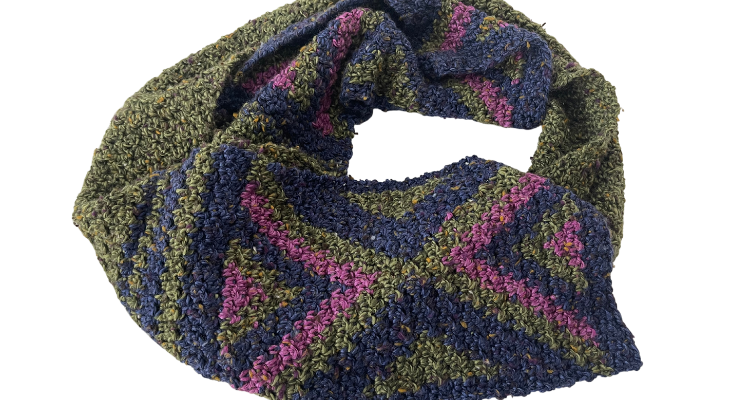
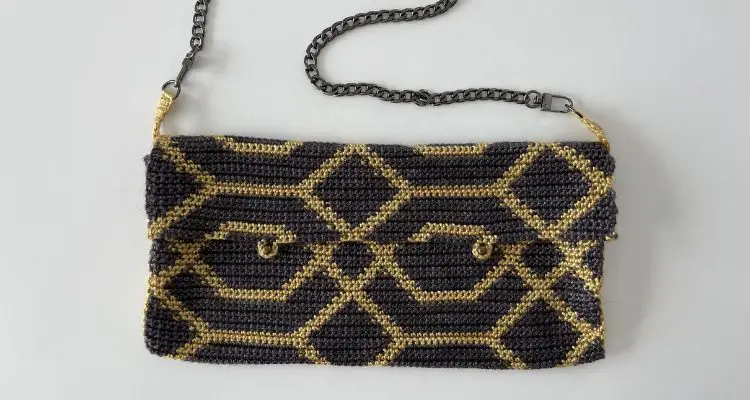
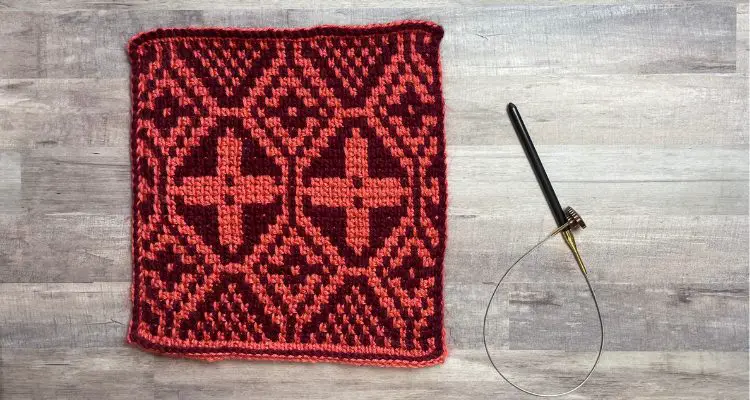
Pin it for Later
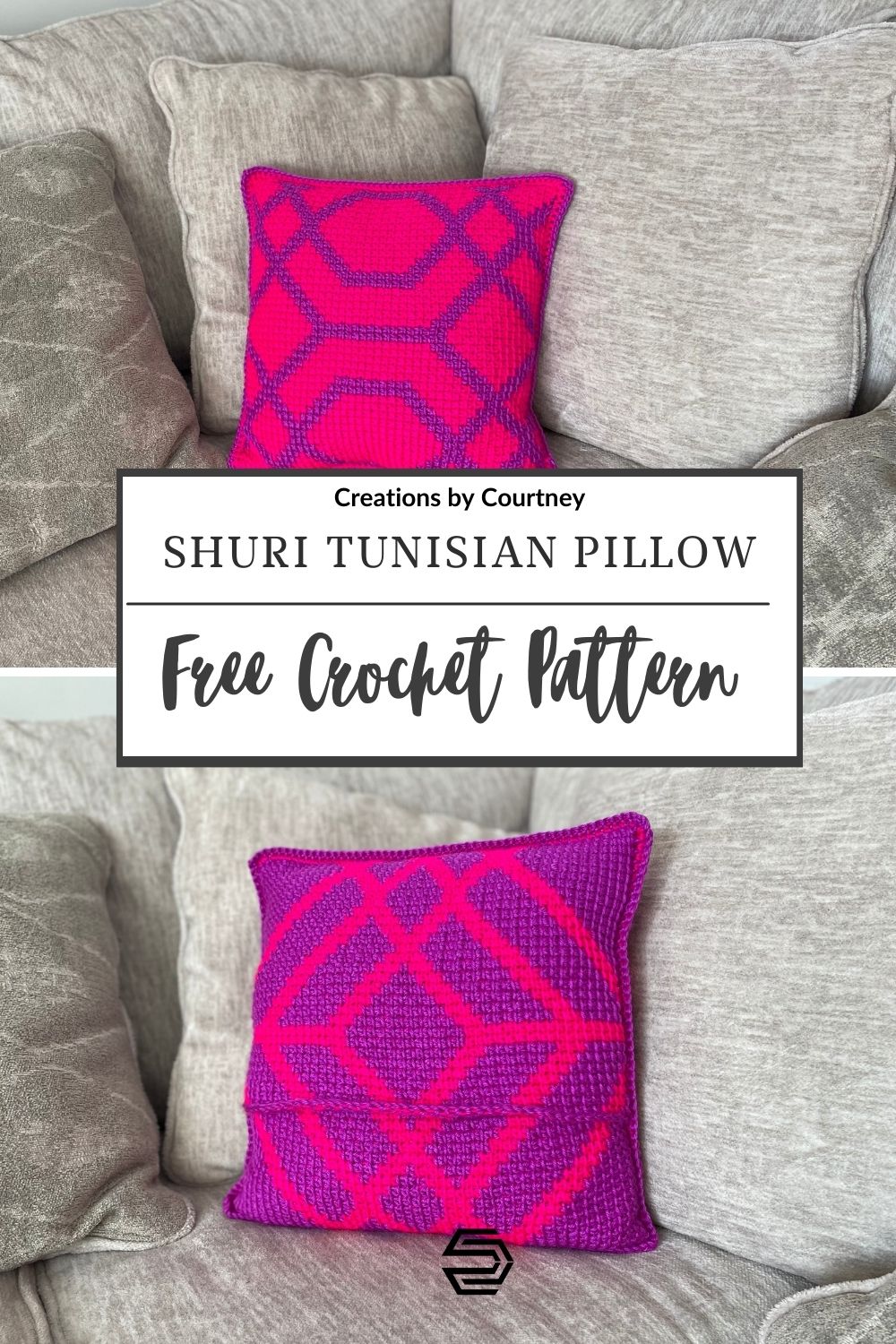
Want to talk about yarn goodness, crochet tips, and exclusive weekly deals? Join my Facebook Group, Creations By Courtney Community.
If we’re not hanging out on social media yet, come check me out on Facebook, Instagram and Pinterest.
Join my newsletter for sneak peeks, crochet tips, and more.
Use #CreationsByCourtney on social media when sharing your projects.
This pattern is not to be duplicated or resold, and not to be reproduced commercially. You may sell finished products on Etsy, at farmers markets, and craft fairs, but please credit Creations By Courtney as the pattern’s author.

